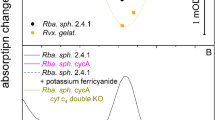Abstract
The initial oxidized species in the photochemical charge separation in reaction centers from Rps. viridis is the primary donor, P+, a bacteriochlorophyll dimer. Bound c-type cytochromes, two high potential (Cyt c 558) and two low potential (Cyt c 553), act as secondary electron donors to P+. Flash induced absorption changes were measured at moderate redox potential, when the high potential cytochromes were chemically reduced. A fast absorption change was due to the initial oxidation of one of the Cyt c 558 by P+ with a rate of 3.7×106s-1 (τ=270nsec). A slower absorption change was attributable to a transfer, or sharing, of the remaining electron from one high potential heme to the other, with a rate of 2.8×105s-1 (τ=3.5 μsec). The slow change was measured at a number of wavelengths throughout the visible and near infrared and revealed that the two high potential cytochromes have slightly different differential absorption spectra, with α-band maxima at 559 nm (Cyt c 559) and 556.5 nm (Cyt c 556), and dissimilar electrochromic effects on nearby pigments. The sequence of electron transfers, following a flash, is: Cyt c 556→Cyt c 559→P+. At lower redox potentials, a low midpoint potential cytochrome, Cyt c 553, is preferentially oxidized by P+ with a rate of 7×106s-1 (τ=140 nsec). The assignment of the low and high potential cytochromes to the four, linearly arranged hemes of the reaction center is discussed. It is concluded that the closest heme to P must be the high potential Cyt c 559, and it is suggested that a likely arrangement for the four hemes is: c 553 c 556 c 553 c 559P.
Similar content being viewed by others
Abbreviations
- diaminodurene:
-
2,3,5,6-tetramethyl-p-phenylenediamine
- MOPS:
-
3-[N-morpholino]-propane-sulfonic acid
- PMS:
-
methyl phenazinium methosulfate
- PES:
-
ethyl phenazinium ethosulfate
- TMPD:
-
N,N,N′,N′-tetramethyl-p-phenylenediamine
- TX-100:
-
Triton X-100
References
Parson WW and Ke B (1982) Primary photochemical reactions. In: Govindjee, ed. Photosynthesis: Energy Conversion by Plants and Bacteria, Vol. 1, pp 331–386. New York: Academic Press
Dutton PL and Prince RC (1978) Reaction center-driven cytochrome interactions in electron and proton translocation and energy coupling. In: Clayton RK and Sistrom WR, eds. The Photosynthetic Bacteria, pp 525–570. New York: Plenum Press
Clayton RK and Clayton BJ (1978) Molar extinction coefficients and other properties of an improved reaction center preparation from Rhodopseduomonas viridis. Biochim Biophys Acta 501: 478–487
Prince RC, Leigh JSJr. and Dutton PL (1976) Thermodynamic properties of the reaction center of Rhodopseudomonas viridis: In vivo measurement of the reaction center bacteriochlorophyll-primary acceptor intermediary electron carrier. Biochim Biophys Acta 440: 622–636
Tiede DM, Prince RC and Dutton PL (1976) EPR and optical spectroscopic properties of the electron carrier intermediate between the reaction center bacteriochlorophylls and the primary acceptor in Chromatium. Biochim Biophys Acta 449: 447–467
Tiede DM, Leigh JS and Dutton PL (1978) Structural organization of the Chromatium vinosum reaction center associated c-cytochromes. Biochim Biophys Acta 503: 524–544
Deisenhofer J, Epp O, Miki K, Huber R and Michel H (1984) X-ray structure analysis of a membrane protein complex. Electron density map at 3 Å resolution and a model of the chromophores of the photosynthetic reaction center from Rhodopseudomonas viridis. J Mol Biol 180: 385–398
Deisenhofer J, Epp O, Miki K, Huber R and Michel H (1985) Structure of the protein subunits in the photosynthetic reaction center of Rhodopseudomonas viridis at 3 Å resolution. Nature 318: 618–624
Holten D, Windsor MW, Parson WW and Thornber JP (1978) Primary photochemical processes in isolated reaction centers of Rhodopseudomonas viridis. Biochim Biophys Acta 510: 112–126
Shopes RJ, Wraight CA, Levine LMA and Holten D (1986) Oxidation rate of high potential cytochrome c 558 in reaction centers from Rhodopseudomonas viridis. Biophys J 49: 23a
Wraight CA, Shopes RJ, McComb JC, Levine LMA and Holten D (1987) Some functional characteristics of reaction centers from Rhodopseudomonas viridis. In: Biggins J, ed. Progress in Photosynthesis Research, Vol. 2, pp 387–396. Dordrecht: Martinus Nijhoff
Shopes RJ and Wraight CA (1985) The acceptor quinone complex of Rhodopseudomonas viridis reaction centers. Biochim Biophys Acta 806: 348–356
Prince RC, Tiede DM, Thornber JP and Dutton PL (1977) Spectroscopic properties of the intermediary electron carrier in the reaction center of Rhodopseudomonas viridis: Evidence for its interaction with the primary acceptor. Biochim Biophys Acta 462: 467–490
Tait CD, Holten D, Barley M, Dolphin D and James BR (1985) Picosecond studies of ruthenium (II) and ruthenium (III) porphyrin photophysics. J Amer Chem Soc 197: 1930–1934
Shopes RJ (1986) Electron transfer in the reaction center from Rhodopseudomonas viridis. PhD Thesis. University of Illinois
Case GD, Parson WW and Thornber JP (1970) Photooxidation of cytochromes in reaction center preparations from Chromatium and Rhodopseudomonas viridis. Biochim Biophys Acta 223: 122–128
Kihara T and Chance B (1969) Cytochrome photooxidation at liquid nitrogen temperatures in photosynthetic bacteria. Biochim Biophys Acta 189: 116–124
Moore GR and Williams RJP (1976) Electron-transfer proteins. Coord Chem Rev 18: 125–197
DeVault D (1981) Quantum mechanical tunneling in biological systems. Quart Rev Biophys 13: 387–564
Prince RC, Tiede DM, Leigh JS Jr. and Dutton PL (1978) The orientation of cytochrome c 558 in the photosynthetic membrane of Rhodopseudomonas viridis. 6th Internat Biophys Congr, Kyoto, Japan. Abstr. V-25-(510)
Marcus RA and Sutin N (1985) Electron transfers in chemistry and biology. Biochim Biophys Acta 811: 265–322
Author information
Authors and Affiliations
Rights and permissions
About this article
Cite this article
Shopes, R.J., Levine, L.M.A., Holten, D. et al. Kinetics of oxidation of the bound cytochromes in reaction centers from Rhodopseudomonas viridis . Photosynth Res 12, 165–180 (1987). https://doi.org/10.1007/BF00047946
Received:
Revised:
Accepted:
Issue Date:
DOI: https://doi.org/10.1007/BF00047946




